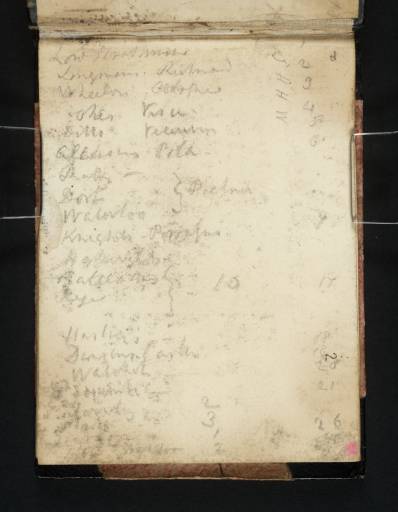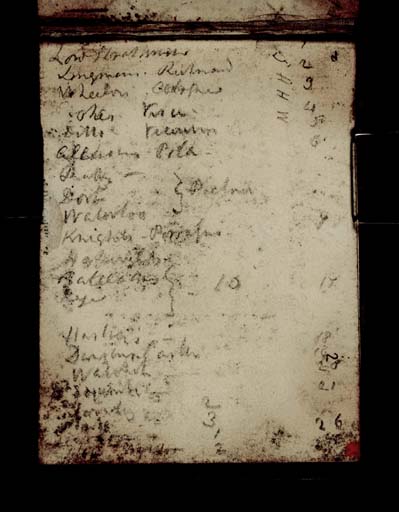Joseph Mallord William Turner Lit of Clients and Works (Inscriptions by Turner) c.1817-20
Image 1 of 2
Joseph Mallord William Turner,
Lit of Clients and Works (Inscriptions by Turner)
c.1817-20
Joseph Mallord William Turner 1775–1851
Folio 35 verso:
Lit of Clients and Works (Inscriptions by Turner) circa 1817–20
D10646
Turner Bequest CXLI 35a
Turner Bequest CXLI 35a
Inscribed by Turner in pencil (see main catalogue entry) on white wove paper, 114 x 88 mm
Inscribed by an unknown hand in ink ‘2’ lower right of centre, descending vertically
Inscribed by an unknown hand in ink ‘2’ lower right of centre, descending vertically
Accepted by the nation as part of the Turner Bequest 1856
References
1909
A.J. Finberg, A Complete Inventory of the Drawings of the Turner Bequest, London 1909, vol.I, pp.406–7, CXLI 35a as ‘list of work in hand’.
1981
John Gage, ‘Turner and the Greek Spirit’, Turner Studies, vol.1, no.2, 1981, p.18.
1981
Eric Shanes, Turner’s Rivers, Harbours and Coasts, London 1981, pp.26, 46, 159 note 38.
1984
Martin Butlin and Evelyn Joll, The Paintings of J.M.W. Turner, revised ed., New Haven and London 1984, pp.98–9, 101, 103.
1984
Cecilia Powell, ‘Turner’s “Antiquities at Pola”: “the art of construction practically arranged”’, Turner Studies, vol.4 no.1, Summer 1984, p.41.
1986
Edward Yardley, ‘The Turner Collector: “That Munificent Gentleman” – James Rivington Wheeler’, Turner Studies, vol.6, no.2, Winter 1986, pp.51 (as ‘p.58a’), 53, 56.
1995
Cecilia Powell, Turner in Germany, exhibition catalogue, Tate Gallery, London 1995, p.77 note 53.
2001
Terry Riggs, ‘James Rivington Wheeler (1758–1834)’, in Evelyn Joll, Martin Butlin and Luke Herrmann eds., The Oxford Companion to J.M.W. Turner, Oxford 2001, p.380.
Turners list reads:
Lord Strathmore 1
Longmans. Richmond 2
Wheeler Cologne 3
Cookes Vesu 4
Ditto Vesuvius 5
Allinson Pola 6
Raby
Dort Pictures
Waterloo
Knights. Panelius 7
Hakewills
Battle Abbey 10 17
Rye
Hastings 18
Dunster Castle 19
Watchet 20
Edgecumbe 21
Farnley 2
... 3
... 1 26
... 2 27
28
Longmans. Richmond 2
Wheeler Cologne 3
Cookes Vesu 4
Ditto Vesuvius 5
Allinson Pola 6
Raby
Dort Pictures
Waterloo
Knights. Panelius 7
Hakewills
Battle Abbey 10 17
Rye
Hastings 18
Dunster Castle 19
Watchet 20
Edgecumbe 21
Farnley 2
... 3
... 1 26
... 2 27
28
Indentifications of many of the works and clients listed here were proposed by Finberg, who thought the list comprised ‘drawings in hand 1817 or beginning 1818’. His notes are the basis of those given, with more detail or revisions, here. In fact Turner also lists oil paintings and some items might be rather later.
John Bowes, 10th Earl of Strathmore (1769–1820) acquired two watercolours of Gibside, County Durham, the Seat of the Earl of Strathmore (Bowes Museum, Barnard Castle)1 painted there in autumn 1817 when Turner visited the estate with Strathmore after his stay at Raby Castle; see notes by Matthew Imms to the Raby sketchbook (Tate D12262–D12317; D40723–D40726; D40764; D41517; Turner Bequest CLVI). The watercolours were engraved for Robert Surtees’s History of Durham. Turner notes the address of Strathmore’s London solicitor on folio 34 verso of the present sketchbook (D10644).
Longman and Co., run by Thomas Longman III (1771–1842) published History of Richmondshire by Dr Thomas Dunham Whitaker, 1819–23, with illustrations after Turner. The watercolour Richmond, Yorkshire, from the North-East (Victoria and Albert Museum, London)2 was painted about 1817 from a drawing in the Yorkshire 5 sketchbook (Tate D11538–D11539; Turner Bequest CXLVIII 10a–11) and is probably the work referred to here.
James Rivington Wheeler (1758–1834), lawyer and collector, commissioned the watercolour Cologne (private collection, Japan)3 which he bought ‘some time between 1818 and 1820.’4 This connection was missed by Finberg. Edward Yardley states that Andrew Wilton’s date of circa 1820 for the watercolour is too late in view of the ‘documentation’ in this sketchbook,5 but not all Turner’s notes here necessarily belong to ‘late 1817 or early 1818.’
Two watercolours of the Bay of Naples, Vesuvius Angry (Williamson Art Gallery, Birkenhead)6 and Vesuvius in Repose (private collection),7 both of about 1817, are said to have been intended for engraving by the Cookes for a publication called Delineations of Pompeii. However this did not appear and the former was later engraved by Thomas Jeavons for a popular annual, Friendship’s Offering, in 1830.
The watercolour Antiquities of Pola (on the London art market in 2009)8 was engraved by George Cooke in 1819 as a frontispiece for Picturesque Views of the Antiquities of Pola, in Istria by Thomas Allason (1790–1852). As noted by Cecilia Powell, Turner was probably at work on the watercolour in November 1817 when he referred to Allason’s project in a letter to James Holworthy.9 Turner’s gift of the watercolour to the aforementioned Mr Wheeler is discussed by Yardley, who concludes that it had previously been loaned to Cooke and was not acquired by Allason.10 Turner’s colour beginning for it is Tate D17184; Turner Bequest CXCVI T.
Turner then lists four oil paintings. Three, bracketed as ‘Pictures’, are works exhibited at the Royal Academy in 1818: Raby Castle, the Seat of the Earl of Darlington (Walters Art Gallery, Baltimore, Maryland);11 Dort, or Dordrecht, the Dort Packet-Boat from Rotterdam Becalmed (Yale Center for British Art, New Haven, Connecticut);12 and The Field of Waterloo (Tate N00500).13
‘Knights Panelius’ refers to the original or a version of View of the Temple of Jupiter Panellenius, in the Island of Aegina, with the Greek National Dance of the Romaika: the Acropolis of Athens in the Distance. Painted from a Sketch Taken by H. Gally Knight, Esq. in 1810 (collection of the Duke of Northumberland),14 exhibited at the Royal Academy in 1816. John Gage (dating the sketchbook ‘about 1816’)15 takes Turner’s citation here and another of ‘Knight’s Picture’ in the Farnley sketchbook (Tate D11998; Turner Bequest CLIII 2a) to suggest that the Northumberland canvas, which lacks certain provenance before 1843, was commissioned or owned by Knight. Henry Gally Knight (1786–1846), author, amateur artist and landowner of Langold Hall, Yorkshire, had supplied Turner with the sketch for the picture. Butlin and Joll list it as signed and dated 1814 but note that the last digit is unclear and that press reports of exhibitions in Manchester in 1845 and Edinburgh in 1847 say that it was painted in 1818 or dated that year, leaving an outside chance that another version was painted.16 Finberg, on the basis that Turner’s list referred to drawings in progress in 1817 or 1818, thought this item was ‘probably a watercolour version’ of the picture or another Temple of Jupiter Panellenius Restored (on the New York art market in 2009)17 also shown in 1816. Turner’s note could also refer to the unpublished Liber Studiorum plate, perhaps engraved by Henry Dawe around 1816, or to an engraving by William Bernard Cooke also based on a sketch by Knight and titled ‘Parnassus’.
The architect James Hakewill (1778–1843) commissioned Turner to make finished watercolours from pencil drawings he had made in Italy in 1816 and 1817, for engraving in his Picturesque Tour of Italy published by John Murray in 1820. Hakewell also commissioned seven other artists but Murray only accepted Turner’s watercolours, using eighteen of the twenty supplied.18 Turner’s work for Hakewill preceded his own fist visit to Italy in 1819.
Next, Turner brackets three Sussex subjects. ‘Battle Abbey’ is probably, as Finberg thought, one of the two watercolours made for John Fuller, the likeliest being Battle Abbey, the Spot where Harold Fell (currently untraced),19 acquired by W.B. Cooke in July 181820 and engraved by him in 1819 for Views in Sussex. ‘Rye’ was possibly linked by Finberg with the watercolour (National Museum of Wales, Cardiff)21 engraved by Edward Goodall in 1824 for Picturesque Views on the Southern Coast of England but on grounds of its ‘greater sophistication’ Eric Shanes is inclined to think that Turner’s ‘drawing ... in hand in 1818’ is a different work (private collection, Canada).22 ‘Hastings’ must, as Finberg thought, be the watercolour now identified as Hastings from the Sea (British Museum, London)23 dated 1818 and acquired on August 31 that year by W.B. Cooke24 with the intention of engraving it for a set of ‘Views at Hastings and its Vicinity’, a sequel to Views in Sussex which never materialised.
The next three items were all identified by Finberg as watercolours for Southern Coast and they too were bought by W.B. Cooke on 31 August 1818: Minehead, Somersetshire (Lady Lever Art Gallery, Port Sunlight)25 engraved by Cooke in 1821; Watchet, Somersetshire (currently untraced)26 engraved by him in 1820; and Mount Edgecomb, Devonshire (currently untraced)27 engraved by Edward Goodall in 1826.
The last three or four items in the left-hand column are almost impossible to make out, partly due to staining of the paper. However Finberg was probably right to read the first as ‘Farnley’, in which case Turner must be referring to his various watercolours of the house and estate made for Walter Fawkes around 1818.28
David Blayney Brown
July 2011
John Gage, Collected Correspondence of J.M.W. Turner with an Early Diary and a Memoir by George Jones, Oxford 1980, p.71 note 4.
How to cite
David Blayney Brown, ‘Lit of Clients and Works (Inscriptions by Turner) c.1817–20 by Joseph Mallord William Turner’, catalogue entry, July 2011, in David Blayney Brown (ed.), J.M.W. Turner: Sketchbooks, Drawings and Watercolours, Tate Research Publication, December 2012, https://www


